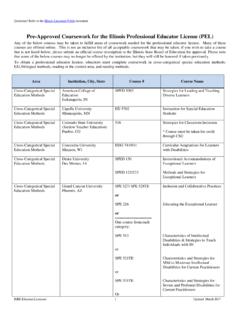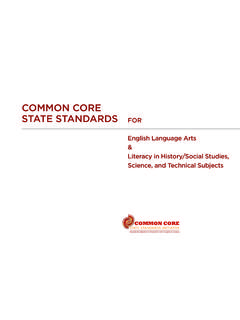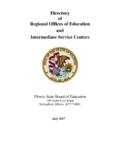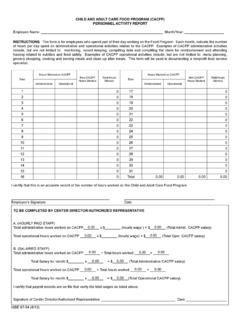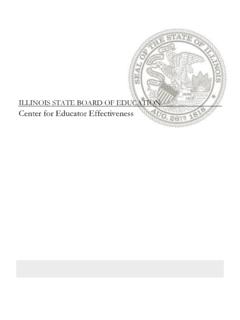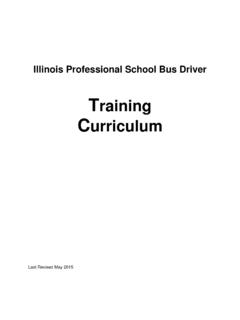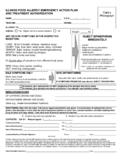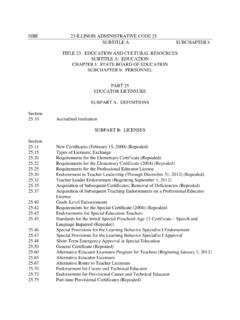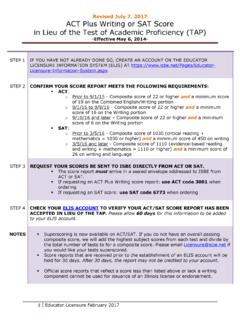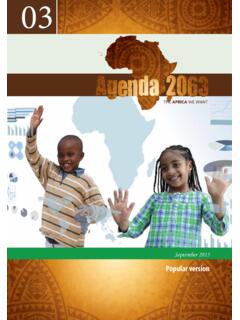Transcription of Illinois Learning Standards for Social Science-6-8
1 Illinois Learning Standards for Social Science-6-8 1 ISBE College & Career Readiness May 2017 Middle School Complexity Levels Grades 6-8: The middle school Standards are banded by levels of complexity rather than grade levels. Because most Social science classrooms are comprised of a wide array of ability levels and challe nges, a complexity continuum was developed to meet the varying cognitive needs of adolescents and address the range of difficulty of the Standards . LC: Less Complex MdC: Moderately Complex MC: More Complex. Inquiry Skills Developing Questions and Planning Inquiries Constructing Essential Questions : Create essential questions to help guide inquiry about a topic . Constructing Supporting Questions : Ask essential and focusing questions that will lead to independent research.
2 Determining Helpfu l Sources : Determine sources representing multiple points of view that will assist in organizing a research plan. Evaluating Sources and Using Evidence Less Complex (LC) Moderately Complex (MdC) More Complex (MC) Gathering and Evaluating Sources : Determine the value of sources by evaluating their re levance and intended use. : Determine the credibility of sources based upon their origin, authority and context. : Gather relevant information from credible sources and determine whether they support each other. Developing Claims and Using Evidence : Appropriately cite all sources utilized. : Identify evidence from multiple sources to support claims, noting its limitations. : Develop claims and counterclaims whil e pointing out the strengths and limitations of both.
3 Communicating Conclusions and Taking Informed Action Less Complex (LC) Moderately Complex (MdC) More Complex (MC) Communicating Conclusions : Construct arguments using claims and evidence from multiple sources, while acknowledging their strengths and li mitations. : Construct explanations using reasoning, correct sequence, examples and details, while acknowledging their strengths and weaknesses. : Present arguments and explanations that would appeal to audie nces and venues outside the classroom using a variety of media. Critiquing Conclusions : Critique the structure and credibility of arguments and explanations (self and others). Taking Informed Action : Analyze how a problem can manifest itself and the challenges and opportunities faced by those trying to address it. : Assess individual and collective capacities to take action to address problems and identify potential outcomes.
4 : Apply a range of deliberative and democratic procedures to make decisions and take action in schools and community contexts. Civics Standards Less Complex (LC) Moderately Complex (MdC) More Complex (MC) Civic and Political Institutions : Identify roles played by citizens (examples: voters, jurors, taxpayers, military, protesters and office holders). : Describe the ro les of political, civ il and economic organizations in shaping people s lives. : Evaluate the powers and responsibili ties of citizens, political parties, interest groups, and the media. : Describe the origins, purposes, and impact of constitutions, laws, treaties, and international agreements. : Explain the origins, functions, and structure of government with reference to the Constitution, Illinois Constitution and other systems of govern ment.
5 : Analyze the power and limits of governments, public officials, and bureaucracies at different levels in the United States and other countries. Illinois Learning Standards for Social Science-6-8 2 ISBE College & Career Readiness May 2017 Participation and Deliberation: Applying Civic Virtues and Democratic Principles , MdC, MC: Compare the means by which individuals and groups change societies, promote the common good, and protect rights. : Explain the connection between interests and perspectives, civic virtues, and democratic principles when addressing issues in govern ment and society. : Analyze the ideas and principles contained in the founding documents of the United States and other countries, and explain how they influence the Social and political system. : Critique deliberative processes used by a wide variety of groups in various settings.
6 ; MdC; MC : Apply civic virtues and democratic principles in school and community settings. Processes, Rules, and Laws : Determine whether specific rules and laws (both actual and proposed) resolve the problems they were meant to address. ; Analyze the purposes, implementation, and consequences of publi c polici es in historic and contemporary settings. : Develop procedures for makin g decisions in his toric and contemporary settings (such as the school, civil society, or local, state or national government). Geography Standards Less Complex (LC) Moderately Complex (MdC) More Complex (MC) Geographic Representations: Spatial Views of the World : Use geographic representations (maps, photographs, satellite images, etc) to explain the relationships between the locations (places and regions) and changes in their environment.
7 : Use mapping and graphing to represent and analyze spatial patterns of different environmental and cultural characteristics. : Construct different representations to explain the spatial patterns of cultural and environmental characteristics. Human-Environment Interaction: Place, Regions, and Culture : Explain how humans and their environment affect one another. : Compare and contrast the cultural and environmental characteristics of different places or regions. : Evaluate how cultural and economic decisions influence environments and the daily lives of people in both nearby and distant places. Human Population: Spatial Patterns and Movements : Explain how environmental characteristics impact human migration and settlement. : Explain how changes in transportation and communic ation influence the spatial connections among human settlements and affect the spread of ideas and culture.
8 : Evaluate the influences of long-term human-induced environmental change on spatial patterns of conflic t and cooperation. Global Interconnections: Changing Spatial Patterns : Identify how cultural and environmental characteristic s vary among regions of the world. : Explain how global changes in population distribution patterns affect changes in land use. : Analyze how the environmental characteristic s of places and production of goods influence patterns of world trade. Standards Economics and Financial Literacy Standards Less Complex (LC) Moderately Complex (MdC) More Complex (MC) Economic Decision Making : Explain how economic decis ions affect the well-being of individuals, businesses and society. : Explain how external benefits and costs influence choices. : Evaluate alternative approaches or solutions to current economic issues in terms of benefits and costs for different groups and society as a whole.
9 Exchange and Markets : Analyze the role of innovation and entrepreneurship in a market economy. : Describe the ro les of institutions, such as corporations, non-profits, and labor unions in a market economy. : Explain how changes in supply and demand cause changes in pric es and quantities of goods and services, labor, credit, and foreign currencies. The National and Global Economy : Explain why Standards of living increase as productivity improves. : Explain barriers to trade and how those barriers influence trade among nations. : Evaluate employment, unemployment, inflation, total production, income and economic growth data and how they affect different groups. Illinois Learning Standards for Social Science-6-8 3 ISBE College & Career Readiness May 2017 Financial Literacy : Analyze the re lationship between skills, education, jobs, and income.
10 : Identify how people choose to buy goods and services while stil l maintaining a budget based on income, taxes, savings, and fixed and variable interest rates. : Describe the connection between credit, credit options, and interest and credit history. : Explain the roles and relationships between savers, borrowers, interest, time, and the purposes for saving. : Explain the correlation between investors, investment options (and associated risks), and income/wealth. : Analyze the re lationship between financial risks and protection, insurance and costs. History Standards Less Complex (LC) Moderately Complex (MdC) More Complex (MC) Change, Continuity, and Context : Classify series of historical events and developments as examples of change and/or continuity. : Analyze connections among events and developments in broader historical contexts.
